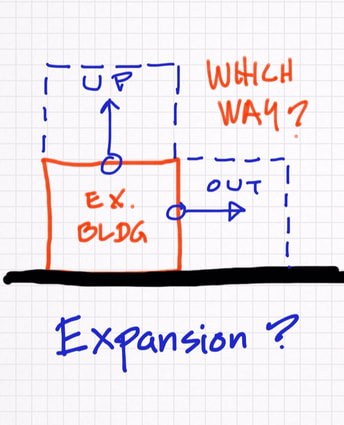|
Look At What Others Do For A Clue. I have posted several articles on the basic design topic of number of stories and how to consider the options. See the links at the end.
Here, I am going to consider the options for expansion of a building that already exists. Technically there are three ways to expand - UP, OUT and DOWN. I have encountered a desire for this last option only once; and I won't surprise you by saying it is not economically feasible and barely construct-able at all. To expand down you are talking mine construction without the benefit of anything substantial above you. While you are excavating the earth below the building you will somehow have to shore up the slab-on-grade, which is not at all structural. Add to that the underground utilities - sewer and storm water - that rest in that earth and have to be relocated (the new depth may be a big problem); and you should be getting the picture. Supporting the walls and structure is almost straightforward by comparison. I am not aware of this having ever been done. If it has, money was no object. As often happens, what you see others doing tells you everything about feasibility and relative costs. EXPANDING UP - This option is more feasible than 'down', but there are serious obstacles unless the building was originally designed for an upward expansion. The biggest obstacle is the structural capacity of the roof, and its flatness. A roof is roughly 1/3 as strong as a floor, and many times the roof structure slopes to drain rainwater. The easiest way to solve this situation is to add a new structure spanning over/above the existing roof structure. How will you support this structure? Independently? Extending the existing structure up? All questions that a structural analysis must address. Adding a new structure overhead makes another problem easier to tackle, too. By leaving the existing roof structure in place, you can remain watertight until a new roof and enclosure can be built. The new design will have to accommodate lots of stuff that penetrates the old roof. Relocating it is part of the solution, but extending duct work up to the relocated rooftop equipment is the type of impact existing roof "furniture" can have on your new floor plan. Then there are the stairs. These may have to go on the exterior if the original building is one-story. But it is complicated rather than unfeasible. Costs are likely to be twice normal construction because of all the remedial work that has to be done. If an upward expansion was designed-in to the original building, the premium may be no more than an addition. Even so, while I have never done it, I have seriously studied it for several clients. In nearly every case, the client decided to relocate rather than pay a premium for a compromised layout. EXPANDING OUT - a straightforward addition is how you see most expansions designed. There are still issues, but they are pretty simple by comparison to UP or DOWN. The first issue is the availability of land for the expansion. Check out zoning setbacks! Work with the authority having jurisdiction before doing much more work that a site plan. My experience is that the bureaucrats get pissy when they think you have ignored them until you are in a jam. The main issues to address early in the design are:
Most of these issues have standard strategies for addressing them. A couple of the less obvious.
Another related consideration when designing any building is its expand-ability. You see some options here that can be considered, and there is one more. Consider adding the extra floor now as a bare shell. Usually there isn't the budget for this approach; but, if you take the long view, this is the least expensive solution. A sub-option is to consider renting the space until needed. Other related posts you might like. Rule Of Thumb for Planning A Basement The Inherent Premium For A Two -Story Building Considerations For The Number Of Stories Comments are closed.
|
x
Archives
February 2024
Categories
All
|
Architekwiki | Architect's Resource | Greater Cincinnati
© 2012-2022 Architekwiki
© 2012-2022 Architekwiki








